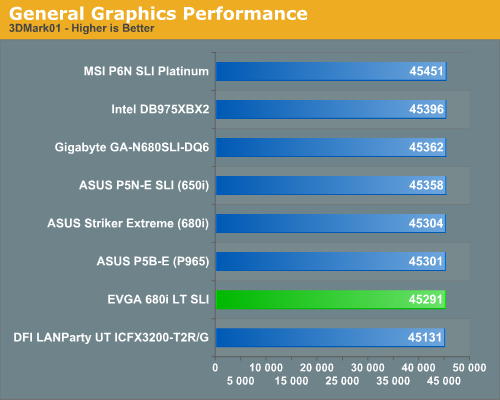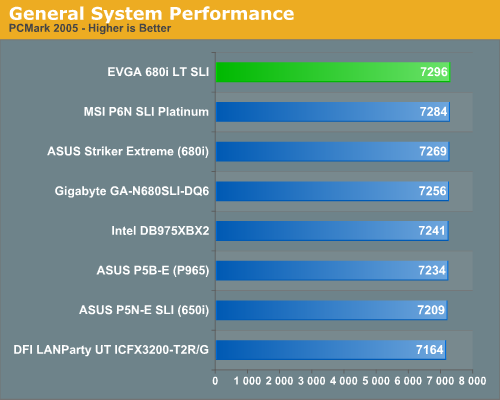EVGA 680i LT SLI: NVIDIA's 680i Cost Reduced
by Gary Key on March 28, 2007 4:00 AM EST- Posted in
- CPUs
Synthetic Graphics Performance
The 3DMark series of benchmarks developed and provided by Futuremark are among the most widely used tools for benchmark reporting and comparisons. Although the benchmarks are very useful for providing apples-to-apples comparisons across a broad array of GPU and CPU configurations they are not a substitute for actual application and gaming benchmarks. In this sense we consider the 3DMark benchmarks to be purely synthetic in nature but still very valuable for providing consistent measurements of performance.


In our 3DMark06 test, each platform score is basically the same although we see the DFI RD600 based motherboard trailing slightly which we attribute to the slightly lower memory and video performance results in our latest BIOS release. Our EVGA board tops the chart and offers the best video performance of our test boards in this benchmark.
In the more memory and CPU sensitive 3DMark01 benchmark we see our EVGA 680i LT board trailing all boards but the RD600, although boards performed slightly better than the other 680i or 650i solutions in our Sandra benchmarks. Given the tight clustering of the scores, however, it is difficult to truly call any of the test candidates "faster" in these particular benchmarks.
General System Performance
The PCMark05 benchmark developed and provided by Futuremark was designed for determining overall system performance for the typical home computing user. This tool provides both system and component level benchmarking results utilizing subsets of real world applications or programs. This benchmark is useful for providing comparative results across a broad array of graphics, CPU, hard disk, and memory configurations along with multithreading results. We consider the PCMark benchmark to be both synthetic and real world in nature and again provided for consistency in our benchmark results.

The EVGA 680i LT board tops our charts in this very competitive benchmark and we are starting to see a pattern emerge with the latest NVIDIA board release performing slightly better than our previous champ, the MSI P6N SLI Platinum. The 650i and 680i chipsets scored very well on the single task disk benchmarks with the 680i performing slightly better in the graphics subsystem tests where they led the field. However, our 975X and P965 chipset boards won the multi-tasking tests while the RD600 offered middle of the road performance in most of the tests.
The 3DMark series of benchmarks developed and provided by Futuremark are among the most widely used tools for benchmark reporting and comparisons. Although the benchmarks are very useful for providing apples-to-apples comparisons across a broad array of GPU and CPU configurations they are not a substitute for actual application and gaming benchmarks. In this sense we consider the 3DMark benchmarks to be purely synthetic in nature but still very valuable for providing consistent measurements of performance.


In our 3DMark06 test, each platform score is basically the same although we see the DFI RD600 based motherboard trailing slightly which we attribute to the slightly lower memory and video performance results in our latest BIOS release. Our EVGA board tops the chart and offers the best video performance of our test boards in this benchmark.
In the more memory and CPU sensitive 3DMark01 benchmark we see our EVGA 680i LT board trailing all boards but the RD600, although boards performed slightly better than the other 680i or 650i solutions in our Sandra benchmarks. Given the tight clustering of the scores, however, it is difficult to truly call any of the test candidates "faster" in these particular benchmarks.
General System Performance
The PCMark05 benchmark developed and provided by Futuremark was designed for determining overall system performance for the typical home computing user. This tool provides both system and component level benchmarking results utilizing subsets of real world applications or programs. This benchmark is useful for providing comparative results across a broad array of graphics, CPU, hard disk, and memory configurations along with multithreading results. We consider the PCMark benchmark to be both synthetic and real world in nature and again provided for consistency in our benchmark results.

The EVGA 680i LT board tops our charts in this very competitive benchmark and we are starting to see a pattern emerge with the latest NVIDIA board release performing slightly better than our previous champ, the MSI P6N SLI Platinum. The 650i and 680i chipsets scored very well on the single task disk benchmarks with the 680i performing slightly better in the graphics subsystem tests where they led the field. However, our 975X and P965 chipset boards won the multi-tasking tests while the RD600 offered middle of the road performance in most of the tests.










16 Comments
View All Comments
MrWizard6600 - Thursday, March 29, 2007 - link
dont know the full details, but the newest P26 Bios from EVGA Removed LinkBoost support“LinkBoost was removed from nForce 680i SLI because it did not show significant demonstrable benefit in games. We had hoped newer games would take advantage of this additional bandwidth but this has not been the case. Please note that future BIOS upgrades will only remove the automatic overclocking component of LinkBoost. Users can still manually overclock the PCI-Express and HyperTransport buses in the BIOS."
SniperWulf - Wednesday, March 28, 2007 - link
Any chance I can get that registry key that you deleted after the nv4_disp crash?yacoub - Wednesday, March 28, 2007 - link
It's time to start recommending Supreme Commander to be the RTS game test choice. Now that there's a new RTS game that can crush systems (SupCom) the way FEAR did for FPS games for the last couple years, a game that makes use of multiple cores at that, we should start to see it used in the suite of games in future motherboard, cpu, and gpu tests. Perhaps Anandtech have already started planning for this?yyrkoon - Wednesday, March 28, 2007 - link
Well, it is not an RTS game, but one I play frequently should also be used to test gaming rigs in my humble opinon. Titan Quest (Immortal Throne if deemed nessisary).My gaming Rig is not top of the line, but it is no slouch, and this game constantly drags in areas that are low light areas, or are outside, and night time. Anyhow, and game that brings my opteron 1210 / ABIT NF-M2 nView / 2 GB DDR2 6400 memory, eVGA 7600GT KO to a crawl, SHOULD be used as a benchmark, at least once in a while. F.E.A.R does not lag like this game does on my system . . .
Stele - Wednesday, March 28, 2007 - link
I agree to an extent, as the current test suite's figures are starting to show their age a wee bit... 100+ FPS, as Quake ended up with newer CPUs/GPUs. Having said that, Anandtech was probably trying to ensure consistency in its tests, so that at the very least, past test results for other products can always be quite easily compared over time. Perhaps in the near future we might see it yet! :)JarredWalton - Wednesday, March 28, 2007 - link
I believe Gary is looking at benching with Supreme Commander. That's one of the games that will be added in future reviews, as far as I know.yacoub - Wednesday, March 28, 2007 - link
Awesome, glad to hear that! One can see the benefit to maintaining benchmark titles for as long as possible to allow the greatest comparison back to past reviews. On the up side, SupCom looks to easily task systems well into the future (much like FEAR has thus far since its release) and would be an excellent choice for the RTS benchmark game. :)yyrkoon - Wednesday, March 28, 2007 - link
Firstly, I have to get this out. It is a completely LAME excuse for nVidia, eVGA, Foxconn, or whomever, to 'claim' the reason this board does not have passive cooling (OTES or equivelent), is to help cut costs. 20 bux less, and they rip out passive cooling ? Lame. Take ABITs NF-M2 nView $85usd , including passive cooling, and moderate other features. Granted, it is based on the NF4 chipset, but who cares, it has passive cooling, and loads of other features for the price.I have to agree somewhat with the first poster, this board is dead, before it even reaches market. Crippled features, missing other features, all for to save $20-$50 usd. Sorry nVidia, and whomever else, but you have not only completely wasted your time, but ours as well, for having to read a review on such a shitty product.
yacoub - Wednesday, March 28, 2007 - link
very much agree. the passive cooling is (and should be) an integral feature of current generation motherboards. there's no reason ANY motherboard released today should require active northbridge (or southbridge) chipset cooling (unless you're overclocking, obviously).yyrkoon - Wednesday, March 28, 2007 - link
One thing I did keep wondering the whole time I was reading the article, and you were mentioning how the BIOS was basically a crippled version of the full blown i680 SLI version was: 'I wonder how soon someone would mod a BIOS version based on the i680 SLI chipset BIOS, to add removed 'features' such as certain voltage settings, etc.'Also, Jarred, or whomever else would like to answer, how hot does the PWM section of this motherboard run ? Seems lately, dual core on up motherboards tend to run hot in the PWM.